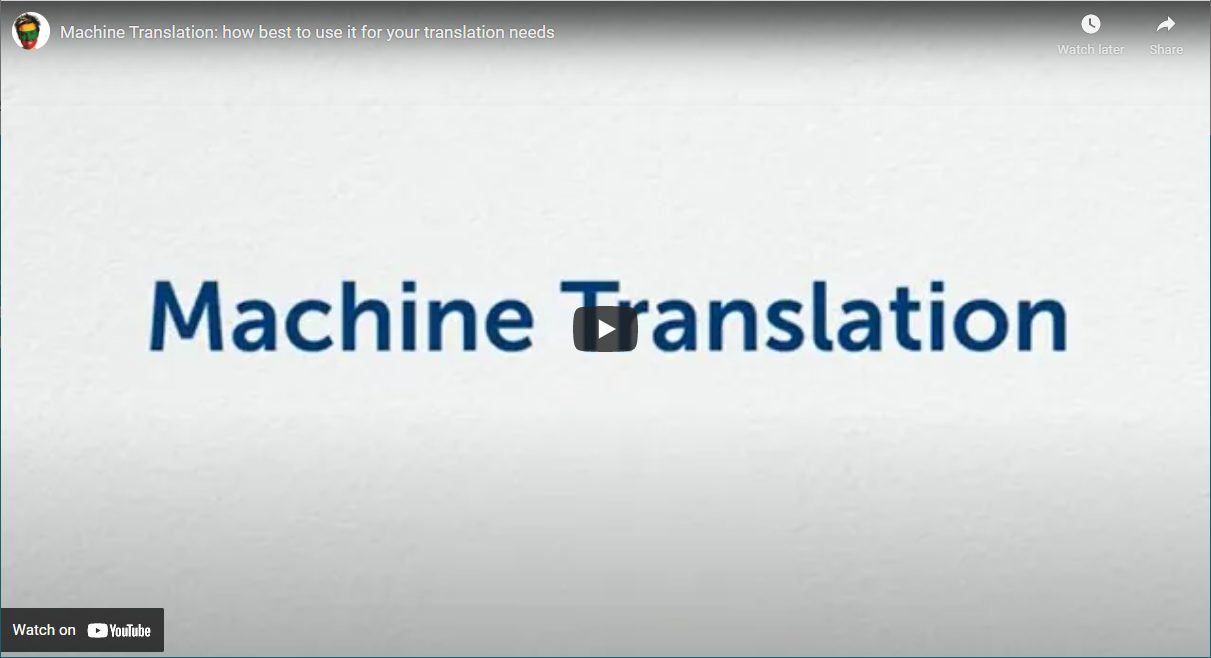Machine Translation: how best to use it for your translation needs
Machine translation technology has seen a huge upsurge in recent times due to the time and cost advantages that it offers. In this blog we look at how best to use machine translation for your translation needs.
Defining Machine Translation
First of all, we should define machine translation: simply put, machine translation describes the process of translating content automatically by a computer rather than by a human. Machine translation is different to Translation Memory or Computer Aided Translation (CAT) tools, which are designed to help human translators be more consistent and efficient. Multiple different machine translation engines exist – some are free to use, others require investment and there are varying degrees of quality – but the premise is largely the same: you input text in one language and the machine delivers the text in another language. When used correctly and in the right scenarios, machine translation can speed up translation projects enormously – time savings that are invaluable in today’s content-driven world.
The majority of machine translation systems work on the basis of a corpus of previous translations that has been pre-loaded into the system in order to help the machine understand and translate other texts. For some languages, huge volumes of translation exist that can be used to build the engine; for other language combinations there are fewer examples on which to draw. Hence, some language combinations work better with machine translation than others, a difference which is accentuated when the structure of the languages is also quite different. It is important to note that machine translation lends itself particularly well to straightforward, formulaic language, rather than creative texts, which are generally more suited to human translation. For particularly creative texts, a serviced called transcreation is often the best option.
Free on-line machine translation vs enterprise level machine translation engines
Free, on-line machine translation tools can sometimes produce questionable results and are not suitable for confidential content, as all data entered for translation remains in the database in order to improve the output (in theory your content and translation could be suggested to someone else using the system). Other, relatively low-cost solutions exist, that are still generic (albeit with generally better output) but which guarantee the security of your data. The huge benefit of both these systems is their cost – they require little or no investment, so they can be very useful in specific scenarios: getting the gist of a document, translating a first draft of a generic piece of content, etc. However, the real power of machine translation lies in the training of enterprise-level engines with company-specific material. These machine translation systems allow for customisations and updates with preferred terminology. Whilst requiring significant time and financial investment, they can produce much better output. Nevertheless, all machine translations will need checking and most will still require editing from a linguist in order to ensure they are correct and appropriate.
Training a machine translation engine
The process of customising a machine translation system is sometimes known as training a machine translation engine, and it can produce much better first-draft translations that require less post-editing, saving time and money in the long-term. Training an engine can involve loading the system with previous, approved translations your company has undertaken, as well as company or industry-specific glossaries, so that the system will produce results that are more appropriate for your content. In addition, these engines can be retrained over time with any changes that are made to the machine translated content, which will improve the quality of the output to produce even better results. This process can require significant time and effort, as well as investment in the machine translation technology, so it is only recommended for companies who process large volumes of translation on a regular basis, where the long-term savings generated from the technology outweigh the investment.
Summary
In summary, when creating a successful machine translation strategy for your business, it is therefore crucial to take into account a number of important considerations.
- Is it the right project? Not all projects lend themselves to utilising machine translation: for example, particularly creative or expressive texts which rely on human flair and consideration. Machine translation should only be used on suitable content that produces quality output.
- The actual machine translation tool needs to be of the right quality. Freely available machine translation engines are generic, will not necessarily produce good enough output and do not always keep your data secure.
- The output is only as good as the input. Good preparation is central to achieving the best results, such as cleaning the available data, loading the machine translation software with previously translated material and terminology databases, bespoke to your business and your vocabulary.
- Every machine translation should undergo a process known as post-editing – where an expert translator will proofread and edit the translated material, to ensure the right level of quality and accuracy from the finished product. For best results, continuous training of the engine over time will ensure improved output, saving time on post-editing and ensuring the best use of your translation budget.
With translation volumes increasing faster than many budgets allow, machine translation can be an incredibly useful tool for streamlining the translation process. Different levels of machine translation exist, with different benefits in terms of cost and quality.
To find out more about machine translation and what it can do for you, please get in touch.
You may also be interested in
https://www.thetranslationpeople.com/technology/machine-translation/
https://www.thetranslationpeople.com/technology/translation-memory/
https://www.thetranslationpeople.com/technology/translation-management-system

